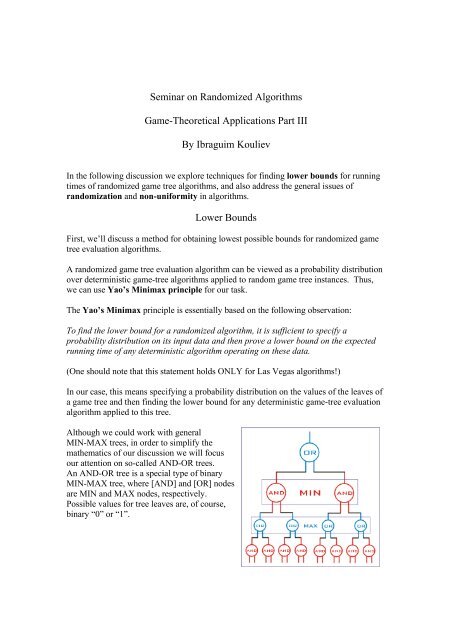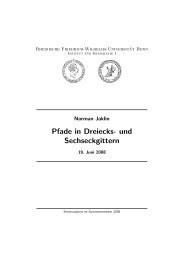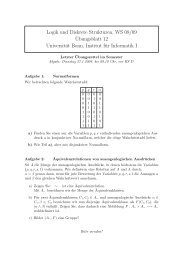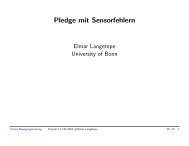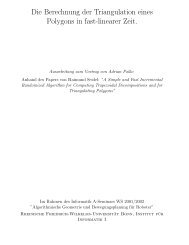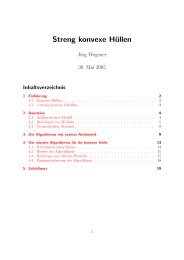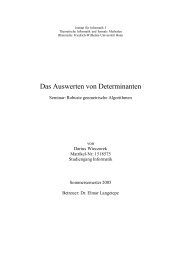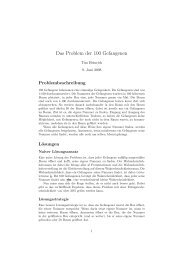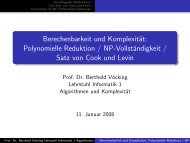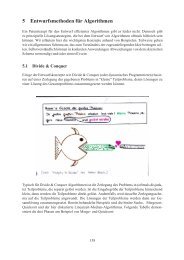Seminar on Randomized Algorithms Game-Theoretical Applications ...
Seminar on Randomized Algorithms Game-Theoretical Applications ...
Seminar on Randomized Algorithms Game-Theoretical Applications ...
Create successful ePaper yourself
Turn your PDF publications into a flip-book with our unique Google optimized e-Paper software.
<str<strong>on</strong>g>Seminar</str<strong>on</strong>g> <strong>on</strong> <strong>Randomized</strong> <strong>Algorithms</strong><br />
<strong>Game</strong>-<strong>Theoretical</strong> Applicati<strong>on</strong>s Part III<br />
By Ibraguim Kouliev<br />
In the following discussi<strong>on</strong> we explore techniques for finding lower bounds for running<br />
times of randomized game tree algorithms, and also address the general issues of<br />
randomizati<strong>on</strong> and n<strong>on</strong>-uniformity in algorithms.<br />
Lower Bounds<br />
First, we’ll discuss a method for obtaining lowest possible bounds for randomized game<br />
tree evaluati<strong>on</strong> algorithms.<br />
A randomized game tree evaluati<strong>on</strong> algorithm can be viewed as a probability distributi<strong>on</strong><br />
over deterministic game-tree algorithms applied to random game tree instances. Thus,<br />
we can use Yao’s Minimax principle for our task.<br />
The Yao’s Minimax principle is essentially based <strong>on</strong> the following observati<strong>on</strong>:<br />
To find the lower bound for a randomized algorithm, it is sufficient to specify a<br />
probability distributi<strong>on</strong> <strong>on</strong> its input data and then prove a lower bound <strong>on</strong> the expected<br />
running time of any deterministic algorithm operating <strong>on</strong> these data.<br />
(One should note that this statement holds ONLY for Las Vegas algorithms!)<br />
In our case, this means specifying a probability distributi<strong>on</strong> <strong>on</strong> the values of the leaves of<br />
a game tree and then finding the lower bound for any deterministic game-tree evaluati<strong>on</strong><br />
algorithm applied to this tree.<br />
Although we could work with general<br />
MIN-MAX trees, in order to simplify the<br />
mathematics of our discussi<strong>on</strong> we will focus<br />
our attenti<strong>on</strong> <strong>on</strong> so-called AND-OR trees.<br />
An AND-OR tree is a special type of binary<br />
MIN-MAX tree, where [AND] and [OR] nodes<br />
are MIN and MAX nodes, respectively.<br />
Possible values for tree leaves are, of course,<br />
binary “0” or “1”.
The first step is a simple modificati<strong>on</strong> of an AND-OR tree, which replaces all [AND] and<br />
[OR] nodes by equivalent elements composed of [NOR] nodes (i.e. an [OR] is a negated<br />
[NOR] etc).<br />
This yields a NOR tree (which has the same depth due to redundancy of some of the<br />
inner nodes). Though identical in terms of functi<strong>on</strong>ality, it also possesses a completely<br />
homogenous structure, which further facilitates our calculati<strong>on</strong>s.<br />
Sec<strong>on</strong>d, we need to specify a probability distributi<strong>on</strong> <strong>on</strong> values of the leaves. Each leaf is<br />
independently set to “1”, with the following probability:<br />
3−<br />
p =<br />
2<br />
5<br />
(Note: our peculiar choice of p will be justified by the next equati<strong>on</strong>.)<br />
The probability of a [NOR] node’s output being “1” is the probability that both inputs are<br />
“0”, i.e.:<br />
⎛ 2 3 − 5 ⎞ ⎛ 2 − 3 − 5 ⎞ ⎛ 5 −1⎞<br />
3 − 5<br />
(1 − p )(1 − p)<br />
= ⎜ ⎟ ⎜ ⎟ = ⎜ ⎟<br />
−<br />
*<br />
= =<br />
⎝ 2 2 ⎠ ⎝ 2 ⎠ ⎝ 2 ⎠ 2<br />
2<br />
p<br />
Now we c<strong>on</strong>sider some properties of a deterministic algorithm evaluating our tree. Since<br />
we would like to minimize its running time, we make use of the following observati<strong>on</strong>:
For a [NOR] node, the output value will be “0” if <strong>on</strong>e of its<br />
children returns “1”. In such cases, the other child (possibly<br />
an entire sub-tree) will not influence the result, and<br />
therefore, doesn’t need to be inspected.<br />
This leads to a noti<strong>on</strong> of Depth-First Pruning algorithms<br />
(DFPA). A DFPA essentially functi<strong>on</strong>s like a DFS, but it<br />
also stops visiting sub-trees of a node <strong>on</strong>ce its value has<br />
been determined – sub-trees that yield no additi<strong>on</strong>al<br />
informati<strong>on</strong> are “pruned” away.<br />
Observe the following propositi<strong>on</strong>:<br />
Let T be a NOR tree, with all leaves set to the aforementi<strong>on</strong>ed distributi<strong>on</strong>. Let W (T )<br />
denote a minimum, over all deterministic game tree algorithms, of the expected number<br />
of steps to evaluate T. Then, there exists a DFP algorithm, whose expected number of<br />
steps to evaluate T is W (T ) .<br />
Thus, for the purposes of our discussi<strong>on</strong>, we may restrict ourselves to DFPAs.<br />
For a DFPA, traversing a NOR tree with n leaves and aforementi<strong>on</strong>ed probability<br />
distributi<strong>on</strong>, the following holds:<br />
Let h be the distance from the leaves to the node in<br />
questi<strong>on</strong>. Let W (h)<br />
denote the expected number of<br />
leaves the DFPA will need to inspect in order to<br />
evaluate the node.<br />
Then:<br />
W ( h)<br />
= W ( h −1)<br />
+ (1 − p)<br />
⋅W<br />
( h −1)<br />
Here W ( h −1)<br />
is the expected number of leaves visited<br />
while evaluating <strong>on</strong>e of the sub-trees of the node. The<br />
factor ( 1− p)<br />
before the sec<strong>on</strong>d term arises from the<br />
fact that the other sub-tree will <strong>on</strong>ly be visited if the<br />
first sub-tree yielded 0, which will happen with the<br />
probability of ( 1− p)<br />
.<br />
(Note: there is no factor p before the first term, as <strong>on</strong>e might expect, because <strong>on</strong>e of the<br />
sub-trees must be visited under all circumstances, i.e. with 100 percent probability.)<br />
Now we let h = log 2 n (since we are working with a binary tree), and substitute it into the<br />
above equati<strong>on</strong>. The soluti<strong>on</strong> of this equati<strong>on</strong> produces the following result:<br />
W ( h)<br />
≥ n<br />
0.694
We have thereby proven the following theorem:<br />
The expected running time of any randomized algorithm that always evaluates an<br />
instance of a binary MIN-MAX tree correctly is at least n 0.694 , where n=2 k is the number<br />
of leaves.<br />
Our result is slightly less than the bound of n 0.793 presented in the previous discussi<strong>on</strong> by<br />
Alexander Hombach. However, our method is correct (since it is based <strong>on</strong> Yao’s<br />
Technique). One possibility is that our distributi<strong>on</strong> of input values is not optimal, since it<br />
does not preclude the possibility of both inputs to a NOR node being “1”. A distributi<strong>on</strong><br />
that prevents such a possibility would show that the evaluati<strong>on</strong> algorithm introduced in<br />
the previous presentati<strong>on</strong> is indeed optimal.<br />
Randomness and N<strong>on</strong>-Uniformity<br />
In the sec<strong>on</strong>d part of our discussi<strong>on</strong>, we try to answer the following questi<strong>on</strong>:<br />
When is it possible to remove randomizati<strong>on</strong> from a randomized algorithm<br />
For our analysis we need to introduce the noti<strong>on</strong> of a randomized circuit. First, we give<br />
the definiti<strong>on</strong> of a Boolean circuit:<br />
A Boolean circuit with n inputs is a DAG with<br />
following properties:<br />
- It has n input vertices of in-degree 0, labeled<br />
x x ,......<br />
1<br />
,<br />
2<br />
x n<br />
- It has <strong>on</strong>e output vertex of out-degree 0.<br />
- Every inner vertex is labeled with a Boolean<br />
functi<strong>on</strong> from the set [AND, OR, NOT]. A<br />
vertex labeled [NOT] has in-degree 1.<br />
- Every input can be assigned either 0 or 1.<br />
- The output is a Boolean functi<strong>on</strong> of x<br />
1<br />
, x2,......<br />
xn<br />
. The circuit is said to compute this<br />
functi<strong>on</strong>.<br />
- The size of the circuit is the number of vertices in it.
A randomized circuit is very similar to a<br />
Boolean circuit in terms of vertex properties, but<br />
in additi<strong>on</strong> to n circuit inputs it also has several<br />
random inputs, labeled r 1<br />
, r 2<br />
,...... rn<br />
. It computes<br />
a functi<strong>on</strong> of x<br />
1<br />
, x2,......<br />
xn<br />
if following<br />
c<strong>on</strong>diti<strong>on</strong>s hold:<br />
- For all x<br />
1<br />
, x2,......<br />
xn<br />
with f ( x 1<br />
,...., x n<br />
) = 0 the<br />
output of the circuit is 0, regardless of the values<br />
of random inputs.<br />
- If f ( x 1<br />
,...., x n<br />
) = 1, the output is 1 with a<br />
1<br />
probability p ≥ .<br />
2<br />
Now c<strong>on</strong>sider a Boolean functi<strong>on</strong> f :{0,1}<br />
∗ → {0,1 }.<br />
n<br />
Let fn<br />
denote the functi<strong>on</strong> f restricted to inputs from { 0,1} . A sequence C = C 1, C 2,...<br />
is<br />
called a circuit family for f if Cn<br />
has n inputs and computes f n<br />
( x 1<br />
,...., x n<br />
) for all n-bit<br />
inputs ( x<br />
1<br />
, x2,......<br />
xn)<br />
. The family C is polynomial-sized if the size of C<br />
n<br />
is bounded by a<br />
polynomial in n for ∀ n .<br />
A randomized circuit family for f is a family of randomized circuits, which has m<br />
random inputs r , r ,...... r<br />
1 2 m<br />
in additi<strong>on</strong> to inputs x<br />
1<br />
, x2,......<br />
xn<br />
, with r , r ,...... r<br />
1 2 m<br />
being<br />
either 0 or 1 with equal probability. The properties of the circuits c<strong>on</strong>cerning random<br />
inputs are those defined above.<br />
All m-tuples ( r , r 1 2,......<br />
r m)<br />
, for which f ( ,...., )<br />
n<br />
x1 x n<br />
= 1 for a particular n-tuple<br />
( x<br />
1<br />
, x2,......<br />
xn)<br />
, are referred to as “witnesses” - they “testify” to the correct value of<br />
f ( x 1<br />
,...., ) = 1.<br />
n<br />
x n<br />
We now introduce Adleman’s Theorem:<br />
If a Boolean functi<strong>on</strong> has a randomized, polynomial-sized circuit family, then it has a<br />
polynomial-sized circuit family.<br />
As a proof we provide a method that removes randomizati<strong>on</strong> from a randomized<br />
polynomial-sized circuit Cn<br />
for fn( x1,....,<br />
xn,<br />
r1<br />
,.... rm<br />
) and transforms it into a deterministic<br />
polynomial-sized circuit D that computes f x ,...., x ) :<br />
n<br />
n<br />
( 1 n
n<br />
n<br />
First, we c<strong>on</strong>struct a matrix M with 2 rows for each possible n-tuple from { 0,1} and<br />
m<br />
m<br />
2 columns for each possible random m-tuple from { 0,1} . An entry M<br />
ij is 1 if the<br />
corresp<strong>on</strong>ding m-tuple is witness for ( x 1<br />
,...., x n<br />
) , and 0 otherwise. Next, we eliminate all<br />
rows for which f evaluates to 0, as there are no witnesses for such inputs.<br />
We start the c<strong>on</strong>structi<strong>on</strong> of our circuit by finding a column in which at least half the<br />
entries are 1, that is, fn( x1 ,...., xn,<br />
r1<br />
,.... rm<br />
) = 1for at least half the possible inputs<br />
( x 1<br />
,...., x n<br />
) .<br />
We then c<strong>on</strong>struct a circuit T1<br />
as a copy of Cn<br />
with random inputs “hard-wired” to the<br />
values of the selected m-tuple (note that such a circuit is purely deterministic!), and<br />
decimate the matrix by eliminating the selected column and all the rows that had 1’s in it.
Now we proceed in a similar fashi<strong>on</strong> by selecting another column etc., until there are no<br />
more rows left. As a result, we will have c<strong>on</strong>structed at most n circuits T<br />
1<br />
, T2<br />
,.... Tn<br />
, which<br />
we then combine into the final deterministic Boolean circuit, whose size is ( n +1)<br />
times<br />
the size of the original randomized circuit.<br />
Our method is an example of a derandomizati<strong>on</strong> technique. Derandomizati<strong>on</strong> often<br />
proves useful in design of deterministic algorithms – sometimes it is easier to devise a<br />
randomized algorithm as a soluti<strong>on</strong> to some problem, and then derandomize it to arrive at<br />
a deterministic algorithm. Unfortunately, it is not always possible or feasible to remove<br />
randomizati<strong>on</strong> from polynomial-time computati<strong>on</strong>s, due to the issue of n<strong>on</strong>-uniformity in<br />
algorithms.
For further discussi<strong>on</strong> we need to know what can be c<strong>on</strong>sidered a n<strong>on</strong>-uniform<br />
(or a uniform) algorithm:<br />
Let L denote a language over an alphabet ∑ * *<br />
, and a : IN → ∑ , n → a(<br />
n)<br />
be a<br />
mapping from positive integers to strings in L . An algorithm A is said to use the advice<br />
a if <strong>on</strong> an input of length n it is given a string a (n)<br />
<strong>on</strong> a read-<strong>on</strong>ly tape.<br />
A decides L with a if <strong>on</strong> an input x it uses a ( x ) to decide x ∈ L . In other words, a<br />
single a (n)<br />
enables A to decide whether or not x ∈ L for ∀ x , x = n .<br />
A uniform algorithm is an algorithm that doesn’t use such advice strings at all.<br />
A n<strong>on</strong>-uniform algorithm utilizes such advice strings.<br />
For the complexity class P we define the class P / poly as a class of all languages L<br />
that have a n<strong>on</strong>-uniform polynomial-time algorithm A , such that length of all advice<br />
strings a (n)<br />
is polynomial-bounded in n , i.e. a ( n)<br />
= O(<br />
poly(<br />
n))<br />
. Likewise, we may<br />
define the class RP / poly .<br />
As an example, imagine a n<strong>on</strong>-uniform algorithm A that processes words<br />
*<br />
{ x ∈∑ , x = n}<br />
. Let a(n)<br />
c<strong>on</strong>tain all { x ∈ L,<br />
x = n}<br />
. L would be in P / poly if the total<br />
number of words in L were bounded by poly (n)<br />
.<br />
Similarly, we may speak of a language L as having a randomized circuit family. Then,<br />
L ∈ RP / poly if and <strong>on</strong>ly if it has a randomized polynomial-sized circuit family.<br />
Hence, <strong>on</strong>e may interpret Adleman’s Theorem as a proof that<br />
RP / poly ⊆ P /<br />
poly<br />
However, this <strong>on</strong>ly shows that removal of randomizati<strong>on</strong> can be d<strong>on</strong>e in principle. There<br />
exist no uniform or practical methods for achieving this.<br />
SUMMARY<br />
In this discussi<strong>on</strong>, we have covered the topics of randomized game tree algorithms,<br />
Minimax Principle and V<strong>on</strong> Neumann’s Theorem, as well as Yao’s Techinques as<br />
powerful tools for bound estimati<strong>on</strong>. We also presented a method for evaluating the<br />
lowest possible bound for a randomized algorithm, and addressed the issues of<br />
randomizati<strong>on</strong> removal and n<strong>on</strong>-uniformity in algorithms.<br />
Bibliography:<br />
<strong>Randomized</strong> <strong>Algorithms</strong>” by Rajeev Motwani and Prabhakar Raghavan<br />
Cambridge University Press, 1995


